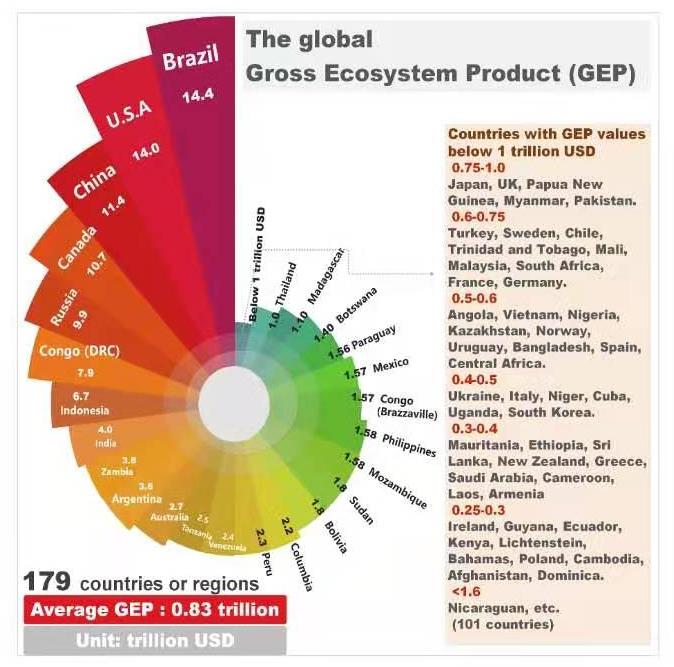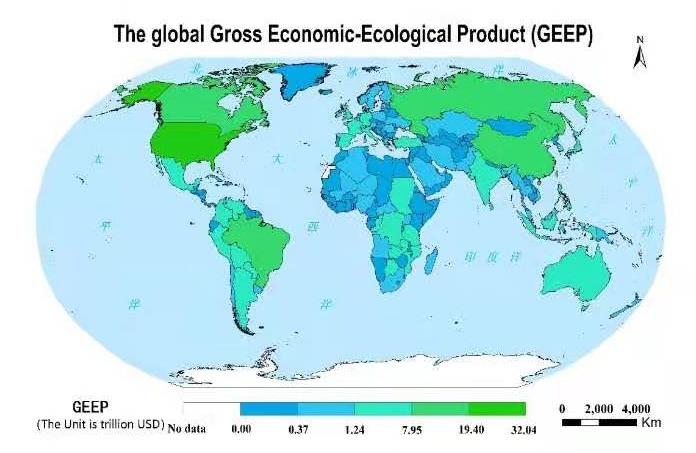

Date issued:2021-03-09
A green accounting system to better value nature
1 FEBRUARY 2021
Current national economic accounting systems do not reflect the resource and environmental costs of economic growth, nor the contribution of ecosystems to the economic growth. But using the ‘Gross Economic-Ecological Product’ instead of traditional GDP does.
Nature provides abundant resources and an ecological foundation for human economic development. The fact that many of these natural resources are public goods has often led to the so-called Tragedy of the Commons, where resources are depleted and ecosystems and biodiversity are threatened due to uncoordinated human activities.
At sea, overfishing and pollutant discharge have affected 66% of the world’s oceans. On land, global land productivity has been reduced by 23%. And in the air, the disappearance of pollinators has led to a loss of $235-577 billion in agricultural products. The destruction of coastal habitats and corals reefs from floods and hurricanes continues to threaten the lives and livelihoods of millions of people.
Current national economic accounting systems for the most part do not reflect the resource and environmental costs of economic growth. They do not reflect the total change in the accumulation of social wealth and social welfare, and cannot fully reflect the contribution of ecosystems to economic growth. The United Nations Statistics Division’s System of Environmental-Economic Accounting (SEEA) is working to change that by deducting the cost of natural resource depletion and pollution from traditional GDP accounting system in order to more realistically measure economic development and welfare.
Green accounting in China
To make up for the shortcomings of traditional national economic accounting, China started to implement in 2006 "green GDP" accounting (deducting the environmental costs of economic development) and Gross Ecosystem Product (GEP) accounting in 2015, in collaboration with the International Union for Conservation of Nature (IUCN), which measures the total economic value of all ecosystem products and services. But green GDP and GEP did not fully incorporate the ecosystem and economic system into the same accounting system.

To this end, the Chinese Academy of Environmental Planning (CAEP) has proposed the Gross Economic-Ecological Product (GEEP) for the first time. GEEP is based on the gross output value of the economic system, taking into account both the damage to the ecological environment in economic activities and the contribution of the ecosystem to the economic system.
China has completed GEEP accounting for 31 provinces, municipalities and autonomous regions from 2015 to 2019. Calculations show that China's GEEP has increased from $18.38 trillion in 2015 to $22.6 trillion in 2019, with an average annual growth rate of 5.3%. Among them, the green GDP after deducting pollution losses increased from $10.3 trillion in 2015 to $14.06 trillion in 2019, with an average annual growth rate of 8.1%. The GEP, which reflects the ecological value, increased from $10.88 trillion in 2015 to $13.35 trillion in 2019, with an average annual growth rate of 5.2%, achieving simultaneous economic and ecological growth.
At the local level, 30 provinces and cities, including Fujian, Guizhou and Tibet, have been actively carrying out GEEP accounting. They have also been exploring ecological compensation based on GEEP accounting, the realization of the value of ecological product, off-office auditing of decision-makers, ecological civilization, green development performance evaluation, natural resource balance sheets, and policy design related to ecological investment and financing, land and space planning and use.
Going global
Research shows that the global GEEP in 2017 was $212.28 trillion, which was 2.7 times the total GDP of that year, of which the value of ecosystem services reached $132.75 trillion, accounting for 62.53%.
From the geographical perspective, the ratio of the total amount of GEEP in the Americas and Africa is significantly higher than its GDP ratio in the world. The GEEP in the Americas is close to $85 trillion. The global GEEP per capita and GEEP per area are 28,400 US$/person and 1,462,300 US$/km2, respectively. The GEEP per capita in Oceania and the Americas is higher than other regions, and the GEEP per area in the Americas and Europe is higher.

Among the top 30 countries in the global GDP rankings, the rankings of almost all countries have changed except for the United States, China, and Australia. Compared with the GDP cluster, long-established developed countries such as Germany, the United Kingdom and France have fallen into the GEEP cluster of countries with "lower" GEEP levels.
China is increasingly using GEEP accounting in its decision-making as part of a transformation to inclusive, green growth. This includes investing in conservation of ecosystem assets to secure provision of ecosystem services through transregional compensation payments. Given the potential benefits of using GEEP, particularly its ability to integrate resource consumption, environmental damage and ecological benefits into the evaluation system of social and economic development, the accounting system should be included in the scope of the United Nations Statistics Division and on a more international level.
 Comments
Comments




 Home
Home

 京公网安备 11010702002483
京公网安备 11010702002483